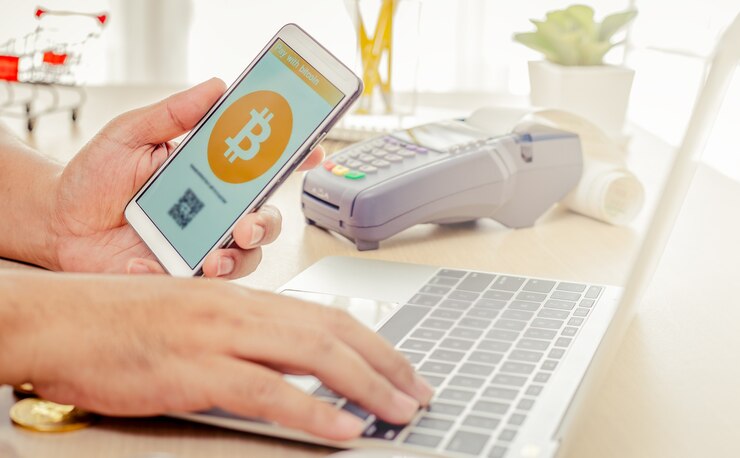
Outline:
1. Introduction To Blockchain payment
- Overview of Blockchain payment and its growing importance in the financial sector.
- Brief explanation of how blockchain technology is transforming traditional payments and transaction systems.
- Preview of the post’s content on the benefits and future trends of blockchain in payments.
2. What is Blockchain Technology?
- Definition and history of blockchain technology.
- Key features of blockchain (decentralization, immutability, transparency).
- Brief mention of blockchain’s applications beyond payments (e.g., supply chain, healthcare).
3. Blockchain Payment: How It Works
- Step-by-step explanation of how blockchain payment systems function.
- Overview of the role of cryptocurrency in blockchain payments.
- Explanation of blockchain’s security features, including encryption and smart contracts.
4. The Role of Blockchain in Revolutionizing Payment Systems
- Blockchain as a decentralized ledger for faster, secure, and transparent payments.
- How blockchain improves cross-border payments and micropayments.
- Impact of blockchain on traditional payment networks (SWIFT, Visa, Mastercard).
5. Blockchain Payment vs. Traditional Payment Methods
- Comparison of blockchain payments with credit cards, wire transfers, and digital wallets.
- Benefits of blockchain payment over traditional methods (e.g., no intermediaries, reduced fees).
- Challenges faced by traditional payment systems and how blockchain addresses these issues.
6. Advantages of Blockchain Payments
- A. Security and Fraud Prevention
- Blockchain’s ability to provide tamper-proof and transparent payment systems.
- Enhanced fraud detection with blockchain.
- B. Lower Transaction Costs
- Elimination of intermediaries and reduction of fees.
- C. Speed and Efficiency
- Faster processing times for transactions, especially in cross-border payments.
- D. Transparency and Accountability
- How blockchain ensures transparency in financial transactions.
- E. Accessibility and Financial Inclusion
- Blockchain’s potential to provide banking services to the unbanked.
7. Blockchain Payment Use Cases in Various Industries
- A. E-Commerce
- How blockchain is changing online payment systems.
- The growing adoption of cryptocurrency in online retail.
- B. Cross-Border Payments
- How blockchain enables faster and cheaper international transactions.
- C. Micropayments
- The potential of blockchain for small-value payments in various sectors (content creation, streaming services).
- D. Banking and Financial Institutions
- The role of blockchain in modernizing banking infrastructure.
- How banks are integrating blockchain into their payment systems.
8. The Challenges of Implementing Blockchain Payments
- A. Regulatory Hurdles
- The current state of regulations surrounding blockchain payments and cryptocurrency.
- B. Scalability Issues
- The technical limitations of blockchain and its impact on transaction speed.
- C. Lack of Awareness and Adoption
- The challenge of educating businesses and consumers on blockchain technology.
9. Future Trends: How Blockchain Will Shape the Future of Payments
- A. Central Bank Digital Currencies (CBDCs)
- The rise of CBDCs and how they integrate blockchain for secure national currencies.
- B. Integration of Blockchain with AI and IoT
- How AI and IoT will work with blockchain to automate payments and transactions.
- C. Blockchain for Digital Identity and Payment Authentication
- Blockchain’s role in identity management for secure and seamless payments.
- D. Wider Adoption of Cryptocurrencies
- The increasing acceptance of cryptocurrency as a global payment method.
10. Blockchain Payment Platforms and Cryptocurrencies
- A. Bitcoin and Blockchain Payment Solutions
- The impact of Bitcoin on the blockchain payment ecosystem.
- Benefits and limitations of Bitcoin in payments.
- B. Ethereum and Smart Contracts for Payments
- The use of smart contracts on Ethereum for automating transactions.
- C. Stablecoins and Blockchain Payments
- How stablecoins solve volatility issues for blockchain payments.
11. Case Studies: Blockchain Payment Systems in Action
- Real-world examples of blockchain payment systems (e.g., Ripple, Stellar, BitPay).
- Success stories from businesses using blockchain for payments.
12. How Businesses Can Integrate Blockchain Payments
- A step-by-step guide for businesses to integrate blockchain payment solutions.
- The potential impact on cost reduction and customer satisfaction.
- Key considerations for selecting blockchain payment providers.
13. The Legal and Regulatory Landscape of Blockchain Payments
- Overview of global regulatory frameworks for blockchain and cryptocurrency payments.
- How different countries are adapting to blockchain payments.
- Key compliance issues and challenges.
14. Conclusion
- Summary of the key points discussed in the post.
- Final thoughts on the future of blockchain payments and their potential to reshape the financial landscape.
15. Frequently Asked Questions (FAQs)
1. What are blockchain payments?
2. How do blockchain payments differ from traditional payments?
3. Can businesses accept cryptocurrency payments through blockchain?
4. What are the advantages of blockchain payments?
5. What are stablecoins, and how do they affect blockchain payments?
How Blockchain Technology is Revolutionizing the Future of Payments and Transactions: A Game-Changer or a Risky Gamble?

1. Introduction
In recent years, blockchain payment technology has been making waves in the financial sector, revolutionizing the way payments are processed and transactions are made. Blockchain, often associated with cryptocurrencies like Bitcoin and Ethereum, has proven to be more than just a tool for digital currency. It is now seen as a game-changer for payments and transactions across industries.
At the heart of this transformation is blockchain technology, a decentralized, transparent, and secure system that ensures efficient and secure transactions. This article explores how blockchain payment systems are reshaping the future of financial services by offering faster, cheaper, and more secure ways to manage transactions. From reducing fraud to enabling cross-border payments with minimal fees, blockchain is proving to be a key technology in the evolution of the global financial landscape.
2. What is Blockchain Technology?
Blockchain technology is a decentralized ledger system that records transactions across multiple computers in a way that ensures security and transparency. It operates without a central authority, relying on a distributed network to maintain and validate records. This ensures that no single party can control the data, and once information is recorded, it cannot be altered.
The main features of blockchain technology are:
- Decentralization: No central authority or single point of control.
- Immutability: Once data is recorded on the blockchain, it cannot be changed or tampered with.
- Transparency: Transactions are visible to all participants in the network, ensuring accountability.
- Security: Blockchain uses cryptographic techniques to secure data, making it resistant to hacking and fraud.
Blockchain’s applications extend far beyond cryptocurrencies. Today, blockchain is being leveraged in industries like healthcare, supply chain management, and, most importantly, payments and financial transactions.
3. Blockchain Payment: How It Works
Blockchain payment systems leverage the power of blockchain technology to facilitate transactions. These transactions can be in the form of cryptocurrency payments (like Bitcoin or Ethereum) or traditional assets that have been tokenized (like real estate or stocks). Here’s how blockchain payments generally work:
- Initiating a Transaction: A user initiates a payment or transaction by creating a request on the blockchain.
- Verification: The transaction is then verified by the network of participants (miners or validators), who use their computing power to confirm the legitimacy of the transaction.
- Execution: Once verified, the transaction is recorded on the blockchain, and the payment is executed. For example, if it’s a cryptocurrency payment, the digital tokens are transferred from one wallet to another.
- Finalization: The transaction is completed, and the payment is stored on the blockchain in a public ledger.
The use of smart contracts on platforms like Ethereum further enhances this process by automating transactions based on predefined conditions, making the entire payment process more efficient.
4. The Role of Blockchain in Revolutionizing Payment Systems
The emergence of blockchain technology has paved the way for significant innovations in payment systems. Here’s how blockchain technology is revolutionizing payments and transactions:
- Decentralization: Traditional payment systems rely on centralized entities like banks or credit card companies to process transactions. Blockchain removes these intermediaries, enabling peer-to-peer transactions without third-party involvement.
- Cross-Border Payments: Blockchain makes it easier and cheaper to send money across borders. Traditional systems often involve high fees and take several days to process cross-border payments. With blockchain, international transactions are processed almost instantly, with lower fees.
- Micropayments: Blockchain is also opening the door for micropayments—small-value transactions that are often impractical with traditional payment systems due to high fees. With blockchain, businesses can process micropayments at a fraction of the cost.
5. Blockchain Payment vs. Traditional Payment Methods
When comparing blockchain payments to traditional payment systems, the benefits of blockchain become apparent. Let’s break down how blockchain stacks up against methods like credit cards, wire transfers, and digital wallets:
- Fees: Traditional payment methods often involve transaction fees, foreign exchange fees, and additional charges for intermediaries. Blockchain payments, especially those using cryptocurrencies, eliminate most of these fees by cutting out middlemen.
- Speed: Traditional payments, especially international wire transfers, can take days to process. Blockchain transactions, in contrast, can be completed in a matter of minutes.
- Security: Blockchain payments are encrypted and stored in an immutable ledger, reducing the risk of fraud and ensuring greater security compared to traditional methods.
While traditional payment systems still dominate the market, blockchain technology offers significant improvements in cost, speed, and security.
6. Advantages of Blockchain Payments
A. Security and Fraud Prevention
One of the key advantages of blockchain payments is the enhanced security they provide. Each transaction is verified by a network of participants and recorded on an immutable ledger, making it incredibly difficult for hackers to alter data. Blockchain’s decentralized nature ensures that no single entity can control or manipulate the data, providing robust protection against fraud.
B. Lower Transaction Costs
Traditional payment methods often involve fees from banks, credit card companies, and other intermediaries. Blockchain payments cut out these middlemen, significantly reducing the transaction costs. This is particularly beneficial for businesses that deal with cross-border payments, where traditional fees can be substantial.
C. Speed and Efficiency
Blockchain payments can be processed much faster than traditional payment methods. Cross-border transactions that would normally take several days can now be completed within minutes, making blockchain an ideal solution for businesses and consumers alike.
D. Transparency and Accountability
Blockchain’s transparent ledger system allows all participants to view the history of transactions, ensuring greater accountability. This transparency builds trust among users and reduces the risk of errors or fraudulent activities.
E. Accessibility and Financial Inclusion
Blockchain has the potential to provide banking services to people who are underserved or excluded from traditional financial systems. With blockchain payment solutions, individuals without access to banks can participate in the global economy by using their mobile devices to send and receive money.
7. Blockchain Payment Use Cases in Various Industries
A. E-Commerce
E-commerce businesses are increasingly adopting blockchain payment systems to allow customers to pay with cryptocurrencies like Bitcoin and Ethereum. Blockchain payments offer e-commerce merchants lower fees, faster processing times, and the ability to tap into a global customer base.
B. Cross-Border Payments
Blockchain is revolutionizing cross-border payments by offering faster and more affordable alternatives to traditional bank transfers. With blockchain, companies can send money to international clients and vendors with lower fees and without having to wait several days for processing.
C. Micropayments
Blockchain technology facilitates micropayments in industries like content creation and streaming. Artists, musicians, and other creators can receive small payments directly from their audience without intermediaries, allowing for a more direct relationship between content creators and consumers.
D. Banking and Financial Institutions
Blockchain is being integrated into banking systems to streamline payments, reduce fraud, and increase transparency. Financial institutions are leveraging blockchain payment systems to offer their customers quicker and cheaper payment options.
8. The Challenges of Implementing Blockchain Payments
While the benefits of blockchain payments are clear, there are several challenges that must be addressed:
A. Regulatory Hurdles
The legal and regulatory framework surrounding blockchain payments is still evolving. Many countries have yet to fully regulate cryptocurrencies and blockchain technology, which creates uncertainty for businesses and consumers.
B. Scalability Issues
Blockchain technology, especially on networks like Bitcoin, faces scalability issues that can lead to slower transaction times and higher fees during periods of high demand. However, newer blockchain platforms like Ethereum 2.0 and Solana are working to address these challenges.
C. Lack of Awareness and Adoption
Many businesses and consumers are still unaware of blockchain’s potential. Widespread adoption will require education and trust-building to overcome resistance to change and foster understanding.
9. Future Trends: How Blockchain Will Shape the Future of Payments
A. Central Bank Digital Currencies (CBDCs)
CBDCs are digital currencies issued and regulated by central banks, and many countries are exploring how blockchain can be used to support these currencies. CBDCs could revolutionize the way governments and financial institutions handle payments and transactions.
B. Integration of Blockchain with AI and IoT
In the future, AI and IoT will work alongside blockchain to create highly efficient payment systems. AI can optimize transaction processing, while IoT devices can trigger payments automatically, further enhancing the efficiency and convenience of blockchain payment systems.
C. Blockchain for Digital Identity and Payment Authentication
Blockchain will likely play a significant role in digital identity management, offering secure and seamless ways to authenticate users for payments. This could lead to easier, more secure, and more private payment experiences.
D. Wider Adoption of Cryptocurrencies
The increasing acceptance of cryptocurrencies as a legitimate payment method will drive further adoption of blockchain payment solutions. As more retailers, businesses, and financial institutions integrate blockchain into their systems, cryptocurrency payments will become more mainstream.
10. Blockchain Payment Platforms and Cryptocurrencies
A. Bitcoin and Blockchain Payment Solutions
Bitcoin, as the first cryptocurrency, plays a significant role in the blockchain payment landscape. It is widely used for both peer-to-peer payments and cross-border transactions. Bitcoin offers security, transparency, and low transaction fees, making it an ideal option for blockchain-based payments.
B. Ethereum and Smart Contracts for Payments
Ethereum extends the capabilities of blockchain payments through smart contracts. These self-executing contracts allow for the automatic execution of payment terms, making transactions more efficient and secure.
C. Stablecoins and Blockchain Payments
Stablecoins are cryptocurrencies pegged to a stable asset like the U.S. dollar, addressing the volatility of other cryptocurrencies. Stablecoins offer the best of both worlds—fast, low-cost blockchain payments with the stability of traditional currencies.
11. Case Studies: Blockchain Payment Systems in Action
Several companies and organizations have already begun adopting blockchain payment systems to streamline payments and improve customer experiences. Case studies such as Ripple, Stellar, and BitPay showcase the real-world application of blockchain technology in payments.
12. How Businesses Can Integrate Blockchain Payments
To integrate blockchain payments, businesses need to:
- Choose the right blockchain platform (e.g., Bitcoin, Ethereum, Ripple).
- Set up payment gateways to accept cryptocurrency payments.
- Ensure compliance with local regulations and security standards.
- Educate staff and customers on how blockchain payments work.
READ MORE: How To Start A Business:A Step by Step Guide For 2025
13. The Legal and Regulatory Landscape of Blockchain Payments
The legal landscape for blockchain payments is still developing. Businesses must stay informed about local laws regarding cryptocurrencies, digital payments, and blockchain technology to ensure compliance.
14. Conclusion
Blockchain payment systems are undeniably transforming the way financial transactions are conducted. With benefits like reduced fees, faster processing times, and enhanced security, blockchain is becoming a powerful tool in the future of payments. As the technology matures and adoption grows, we can expect blockchain to play an even larger role in reshaping the global financial ecosystem.
15. Frequently Asked Questions (FAQs)
1. What are blockchain payments?
Blockchain payments are transactions that use blockchain technology to facilitate secure, fast, and transparent payment processing without the need for intermediaries.
2. How do blockchain payments differ from traditional payments?
Blockchain payments are decentralized, faster, more secure, and often have lower fees than traditional methods like credit cards and bank transfers.
3. Can businesses accept cryptocurrency payments through blockchain?
Yes, businesses can integrate blockchain payment solutions to accept cryptocurrencies such as Bitcoin and Ethereum as payment for goods and services.
4. What are the advantages of blockchain payments?
Blockchain payments offer benefits like security, transparency, lower transaction costs, and faster transaction times compared to traditional methods.
5. What are stablecoins, and how do they affect blockchain payments?
Stablecoins are cryptocurrencies pegged to a stable asset like the dollar. They offer the benefits of blockchain payments without the volatility of other cryptocurrencies.







